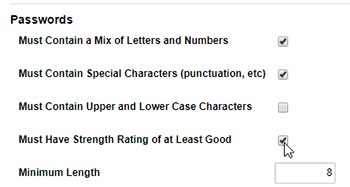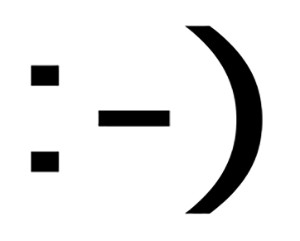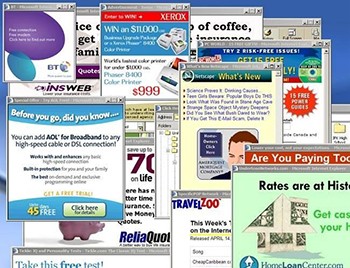5 Online Creators Who Regret Their Creations

We're not going to say any of the people on this list should be redeemed just because they regret unleashing some of the annoying shit that now muddles our cyberspace experience. Sure, some of them had good intentions in mind, but hell, there's a pretty famous saying about that, you know. Or is it a meme? Who knows anymore.
The point is that, given the fact that hindsight is 20/20 and it's the year 2020 and all, we might just as well take the time and try to understand how exactly we've messed things up on this here Internet. With no thanks to the following people ...
The Man Who Made Passwords So Damn Difficult Is Very Sorry, You Guys
Don't Miss
Want to be mad at whoever decided that a "strong" password needs numbers and punctuation and the magical farts of a unicorn? Blame IT specialist Bill Burr, the man who inadvertently created all the password rules we cybersurfers have to suffer today. See, poor Burr was working for the U.S. National Institute of Standards and Technology (NIST) in the early 2000s when he was tasked to write up some security guidelines. Not having any current rules or guides to work off, he used a report from the freaking 1980s to write about the importance of numbers, symbols, and changing your passwords every 90 days.

The thing is, those guidelines were meant for security administrators, not regular folks like user buttlick345 on Reddit or whatever. Burr's guidelines have since been updated by the NIST, but not before spreading across the Internet faster than a picture of a Redditor actually licking their own butt. Now, every other website swears by these rules, which is not ideal since no one wants to feel like they're continually doing admin work on the Internet. Or having to reset their password every time they try to log-on to their Domino's account while high. Burr gets this and admits that his complicated rules (that again, weren't meant for us) only resulted in users making up the dumbest, easily breakable passwords like "password1" and changing it to "password2" three months later.
But all these rules and having to regularly change our passwords must surely make it more difficult to break them, right? Nope! Studies done a good decade ago already showed how easy it is to compare people's old and new passwords, complete with special characters and whatnot, and find a pattern to break them. It's how many, many internet accounts get stolen and sold on underground cybercrime forums. While security experts are working hard to create better online security systems so we could eventually break away from passwords altogether, we're still stuck with them for now. Burr's advice? Try to use phrases from literature for your passwords, because it's easier to remember, and because "$crewYou@BillBurr!" might be too obvious.
The Inventor Of The Modern Emoticon Calls Emojis A Virus
Emojis have become such a part of online communication that we now have a World Emoji Day (thanks, Twitter) complete with an emoji anthem (thanks, nobody).
But let's not forget that it all started with the emoticon, a text-based way of showing someone that while you did, call them a shitty dumpster fire, you meant it goodheartedly.

While there are many disagreements about who actually came up with the first emoticon, Professor Scott Fahlman, a computer scientist at Carnegie Mellon University, is widely credited as the first to have created the "turn your head to one side" smiley face back in the '80s. However, he did not expect it to evolve the way it did, saying he kind of feels like Dr. Frankenstein, and calling emojis ugly and unimaginative.

See, even back in the '80s, people had a real struggle reading humor and sarcasm tones in text form. This was no different in the Carnegie Mellon university's message boards, where flame-wars would erupt because someone didn't get a spandex joke, probably. Fahlman, a new computer science professor at the time, proposed using his typed smiley face as a joke marker and the frowny face as a serious marker. The proposal was made in jest more than anything else, but before Fahlman knew it, his simple idea had spread across the ARPANET, and the rest is digital history. People made it a hobby coming up with character strings to create different emoticons, and soon those strings were turned into little pictures, or emojis.
Fahlman's biggest beef with both emoticons and emojis is that they share a lack of specificity, and it irks him that people are trying to make it into some new language. "It's not complete. There's a few hundred nouns, maybe a couple others that function as verbs ... You can't say, 'Well, I can meet you Tuesday or Thursday, but if it's raining neither.'"

Sure, he's right; some emojis have caused quite a stir since we can pretty much make them mean anything we want (looking at you, OK hand saga). And yes, emojis as a whole isn't a language by itself. At least, not yet. Who knows, we might have a complete emoji translation of Shakespeare by 2040 instead of the half-done versions we have now.
The Man Who Invented Pop-Up Ads Is (Surprise) Also Very Sorry
If you grew up with the internet in the late '90s/early '00s and you didn't accidentally (or deliberately) click on those first-gen pop-up ads, it was probably because you were already in the middle of a seizure induced by those insufferable neon colors flashing all over your screen.

And we have Ethan Zuckerman to thank for it. Today, he's the director of MIT's Center for Civil Media, but in the late '90s, he was a website-builder for a little startup called Tripod, and it was there that Zuckerman created the first-ever pop-up ad. Why? Because some big car company accidentally bought a banner ad on a porn site and wanted it covered up.
The car ad couldn't be removed from the site, so Zuckerman came up with a way to make a new window containing a different ad pop up to cover the original. No harm, no foul, everybody won. Except that a few weeks later, Geocities got their hands on Zuckerman's code, and that's the way the internet crumbles.
While pop-up ads still persist all over the web today (because even though everyone seems to hate them, they still kind of work), we now have countless ad blockers either built-in or readily available to curb banners and pop-ups at large. But that creates its own problems since most websites need ad revenue to survive. Zuckerman knows this as he wrote a lengthy piece in The Atlantic, where he calls advertising "the original sin of the web." The man's hindsight is solid, but it's also not wrong to say that we can blame yet another Zucker for the state of online content.
The Guy Who Built The Retweet Admits Mistake
Ah, the retweet. Twitter's sharing mechanism that keeps the hellsite running, and assists the president of the United States in spreading Qanon conspiracies to millions of people. What a feature. It's inventor, Chris Wetherell, has said that the retweet button was like giving a loaded gun to a four-year-old. If you know Twitter at all (or just, like, humanity), you know that's a fair burn.
The triggering event happened back in 2009 when Wetherell led the team whose job it was to build the retweet. The feature took off immediately, only not in the way Wetherell and the uppers expected. See, before the retweet existed, people had to manually share someone else's tweet by copying the text and typing RT and the name of the original tweeter. It was a somewhat arduous task, but it made people actually read what they shared, and at least think about it for a second before sending "Science is a lie and Earth is shaped like a donkey's butt!" into the cybersphere. But then we got the automated retweet, and it became all too easy to hit that button impulsively without applying any critical comprehension beyond "OMG" or "LOL."
FML.
Gamergate was one of the first colossal examples of how online "armies" can use the retweet and coordinate attacks, spreading outrage, and false information so fast that it becomes almost impossible to correct. An analysis of that insidious event showed that, of around 300,000 Gamergate tweets sent over 72 hours, 69% of those tweets were retweets.
Of course, the muddled state of today's social media didn't happen in a Twitter bubble. Facebook -- who until then was just a place where you posted about your incredible life in the hopes that your high school nemesis would drop dead at the mere sight of your amazingness -- soon realized that they had to catch up with the retweet button to compete in an ever-sharing world. And that, dear internet user, is how we got the Facebook mobile share button and more news in our News Feeds. Soon everyone's timelines were flooded with public and often political content, nestled nicely between pictures of people's babies pooping.
Then, of course, came the now historical 2016 US presidential election campaign, with both Twitter and Facebook at the center of targeted misinformation, thanks to the wonderful creation of the one-click share. The takeaway here is that sharing isn't caring anymore, folks. It's propaganda.
The "9/11 Was An Inside Job" Guy Regrets His 2005 Internet Documentary
One could argue that the 9/11 conspiracy theory and the whole "9/11 Truth" movement was the first to really spark the modern-day false flag conspiracy industry. And Dylan Avery, the guy behind the internet documentary film Loose Change, had a big part to play. Hell, the guy estimates that around 100 million people watched his internet-distributed film about how the terrorist attacks were an inside job and that the World Trade Center fell because of controlled demolitions. The whole theory is backed up with pseudoscience and badly misinterpreted footage, but it sparked one of the biggest conspiracy theories ever.
Avery was only 18-years-old back then, and if life has taught us anything, it's that we'll all think we're super capable of solving the world's greatest mysteries at that age. Avery is in his 30s now, and he realizes that he was just a young kid trying to understand the messed-up world he was living in, and turning to the internet to do so.
"I started researching 9/11 and I found an article on the World Trade Center--someone had posted a picture of a controlled demolition and then a picture of the World Trade Center collapsing. And I was like, Wow, O.K. And then you find one article and that article links to 10 others, and before you know it you're up until six in the morning. It's crazy, the information takes over."
Catastrophic and unprecedented events have a way of making the conspiracy machine churn because people want some kind of answer and some kind of truth to make them feel in control, and not like they're losing their goddamn minds. It's understandable, but the paranoia and disregard of actual facts that always seem to come with it destroy any theory's credibility. It's not "truth" if you're nitpicking. It's not "truth" just because you say it is.
Avery might be over everyone questioning him about his documentary, but his movie made people like Alex Jones (who was an executive producer on a later version) see the potential in yelling "false flag!" to summon the mob and create a lot of horrible harm, just to serve his own personal and political agendas. It's like the internet gave us an incredible amount of information, a vast platform for us to share our opinions, and we decided to use it and yell stuff like "Toilet paper is LACED with GOVERNMENT chemicals to CONTROL our BUTTS!," just to get attention.
While Avery can't put the crazy he unleashed back it's bottle, he has since made Black and Blue, a 2016 documentary centered around police brutality against Black people, so at least he's trying to release some good.
Zanandi tries not to yell on Twitter all the time. She really tries. Go follow her.
Top image: Mego Studio/Shutterstock